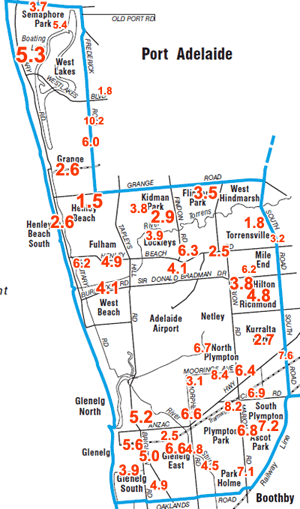Electoral Form Guide: Hindmarsh
Electorate: Hindmarsh
Margin: Labor 6.6%
Location: Western Adelaide, South Australia
In a nutshell: Previous member Chris Gallus did well to hold a naturally Labor-leaning seat for the Liberals from 1993 until her retirement in 2004, when Labor’s Steve Georganas bucked the trend of the election to prevail by a very narrow margin. The 2007 election added enough fat to his margin to push the seat beyond the marginal range.
The candidates
|
|
MATTHEW FISHER
|
|
|
Two-party vote map
|
Swing % map |
Electorate analysis: Created when South Australia was first divided into electorates in 1903, Hindmarsh was traditionally a safe Labor seat covering Adelaide’s working class north-western suburbs. The creation of Port Adelaide as a separate electorate in 1949 made it somewhat less secure, pushing it southwards into more conservative Henley Beach, but only in 1966 was long-term Labor member Clyde Cameron seriously threatened. The watershed moment came in 1993 when the abolition of Hawker drew the election further south into Liberal-voting Glenelg, resulting in a notional Labor margin of just 1.2 per cent. The 1993 election also saw the retirement of John Scott, who had been the member since 1980. The seat was contested for the Liberals by Christine Gallus, who had become the first Liberal ever to win Hawker in 1990. She duly followed this feat by becoming the first Liberal to win Hindmarsh, defeating future state government minister John Rau with a 2.8 per cent swing.
Liberal Party hard-heads rated Gallus’s vote-pulling power very highly, and were duly dismayed when she decided to retire at the 2004 election. The Liberals were also damaged by a redistribution that added a northern coastal spur through Grange to Labor-voting Semaphore, which cut the margin by 0.8 per cent. It was thus widely expected that the seat would fall to Labor candidate Steve Georganas, a former taxi driver backed by the “soft Left” faction in a deal that saw the Right’s Kate Ellis take Adelaide. So it proved, but Georganas was given a run for his money by Liberal candidate Simon Birmingham, who limited the swing to 1.2 per cent and came within 108 votes of victory (he went on to become a Senator in early 2007 when he filled the vacancy created by the death of Jeannie Ferris). The 2007 election provided Georganas with an extra 5.0 per cent buffer – a relatively mild swing by South Australian standards, which saw newly won Makin and Wakefield emerge with bigger margins.
The Liberal candidate is Jassmine Wood, a “small business owner specialising in water systems” who contested the safe Labor seat of West Torrens at the March state election.
 Early in the first week of the campaign, two men were reported for allegedly assaulting a Liberal volunteer who was on the campaign trail with Jassmine Wood. The incident reportedly followed a dispute over the Liberals’ policies on asylum seekers.
Early in the first week of the campaign, two men were reported for allegedly assaulting a Liberal volunteer who was on the campaign trail with Jassmine Wood. The incident reportedly followed a dispute over the Liberals’ policies on asylum seekers.
 The JWS Research-Telereach poll conducted during the final weekend of the campaign, covering 400 respondents in the electorate with a margin of error of about 5 per cent, had Labor leading 56-44.
The JWS Research-Telereach poll conducted during the final weekend of the campaign, covering 400 respondents in the electorate with a margin of error of about 5 per cent, had Labor leading 56-44.
Analysis written by William Bowe. Read Bowe’s blog, The Poll Bludger.





